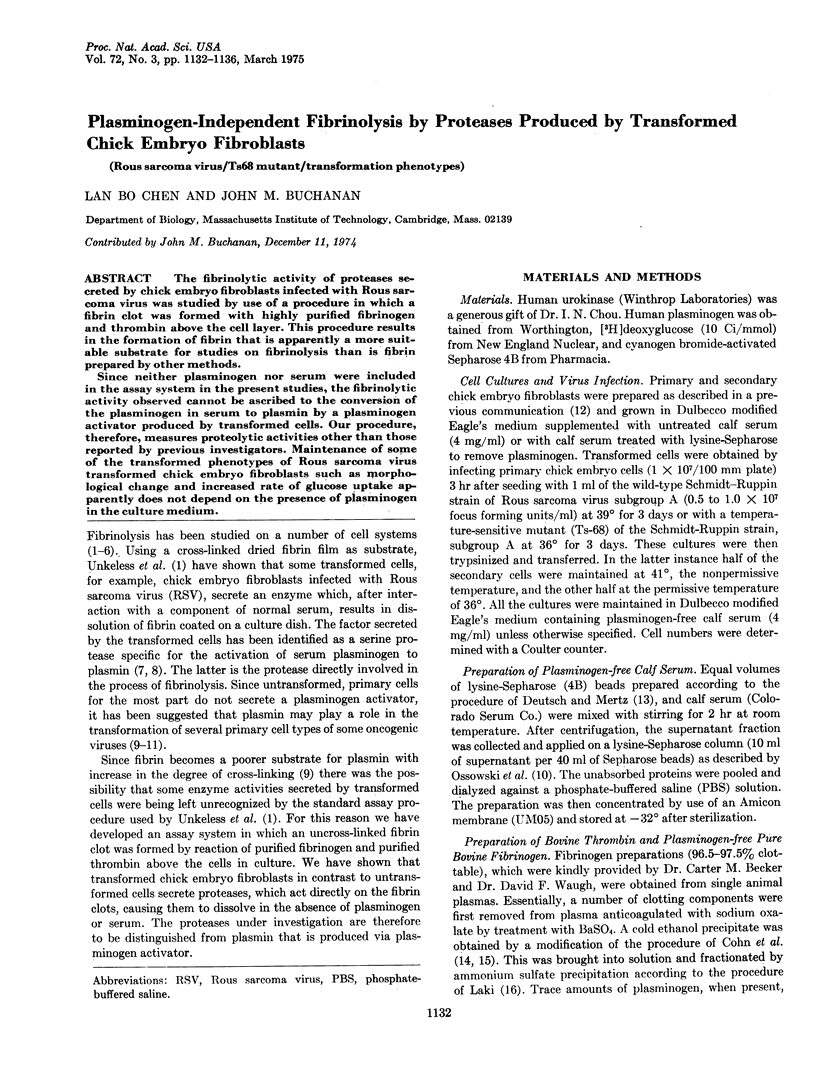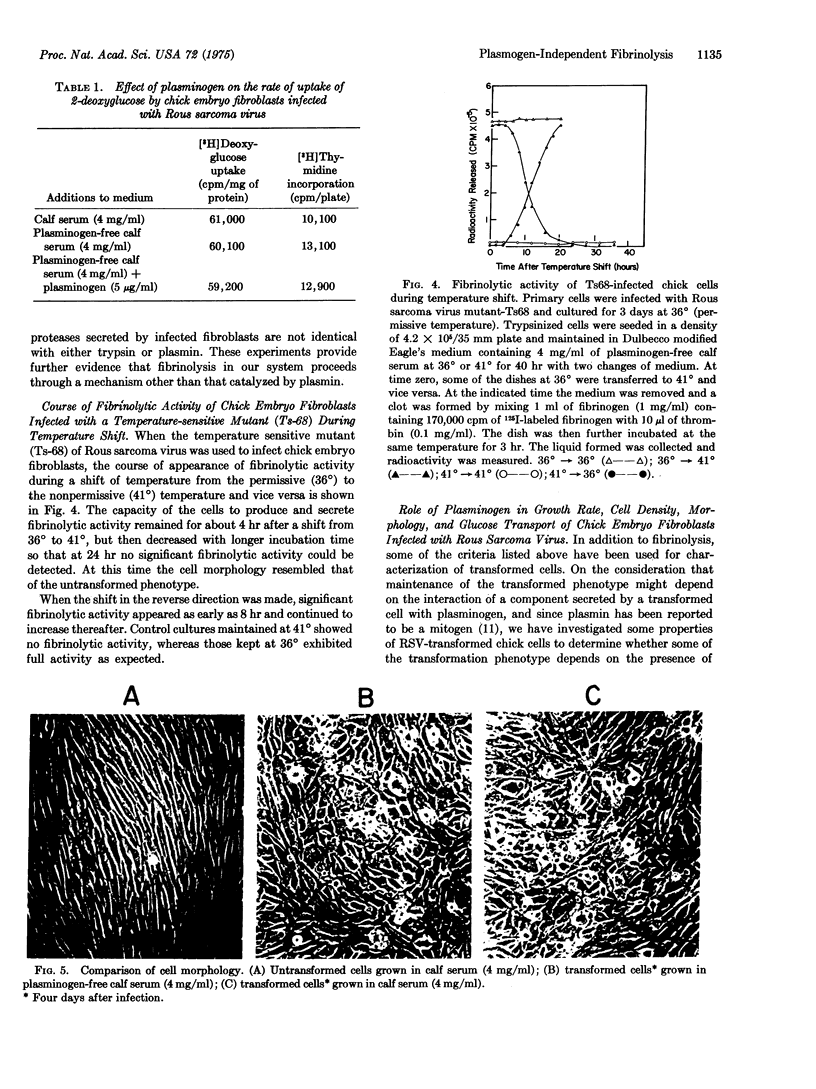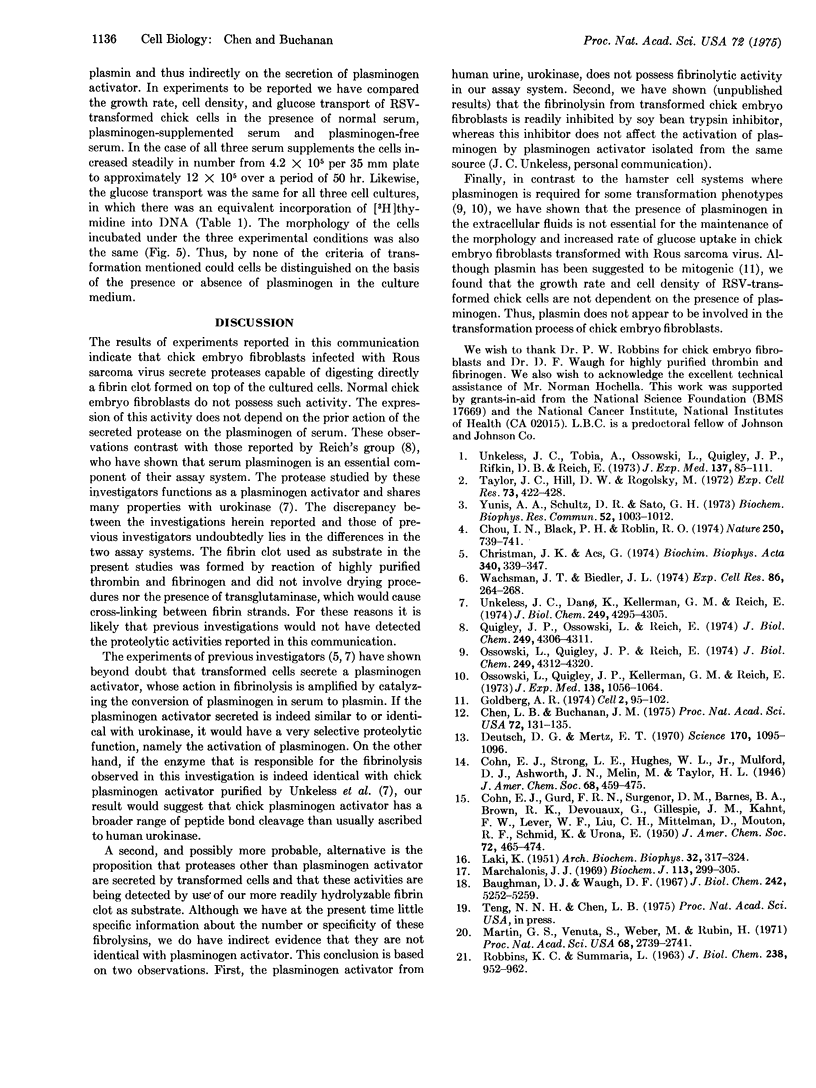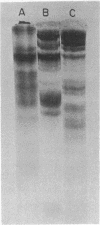Abstract
The fibrinolytic activity of proteases secreted by chick embryo fibroblasts infected with Rous sarcoma virus was studied by use of a procedure in which a fibrin clot was formed with highly purified fibrinogen and thrombin above the cell layer. This procedure results in the formation of fibrin that is apparently a more suitable substrate for studies on fibrinolysis than is fibrin prepared by other methods. Since neither plasminogen nor serum were included in the assay system in the present studies, the fibrinolytic activity observed cannot be ascribed to the conversion of the plasminogen in serum to plasmin by a plasminogen activator produced by transformed cells. Our procedure, therefore, measures proteolytic activities other than those reported by previous investigators. Maintenance of some of the transformed phenotypes of Rous sarcoma virus transformed chick embryo fibroblasts such as morpholigical change and increased rate of glucose uptake apparently does not depend on the presence of plasminogen in the culture medium.
Full text
PDF




Images in this article
Selected References
These references are in PubMed. This may not be the complete list of references from this article.
- Baughman D. J., Waugh D. F. Bovine thrombin. Purification and certain properties. J Biol Chem. 1967 Nov 25;242(22):5252–5259. [PubMed] [Google Scholar]
- Chen L. B., Buchanan J. M. Mitogenic activity of blood components. I. Thrombin and prothrombin. Proc Natl Acad Sci U S A. 1975 Jan;72(1):131–135. doi: 10.1073/pnas.72.1.131. [DOI] [PMC free article] [PubMed] [Google Scholar]
- Chou I. N., Black P. H., Roblin R. O. Suppression of fibrinolysin T activity fails to restore density-dependent growth inhibition to SV3T3 cells. Nature. 1974 Aug 30;250(5469):739–741. doi: 10.1038/250739a0. [DOI] [PubMed] [Google Scholar]
- Christman J. K., Acs G. Purification and characterization of a cellular fibrinolytic factor associated with oncogenic transformation: the plasminogen activator from SV-40-transformed hamster cells. Biochim Biophys Acta. 1974 Mar 27;340(3):339–347. doi: 10.1016/0005-2787(74)90279-2. [DOI] [PubMed] [Google Scholar]
- Deutsch D. G., Mertz E. T. Plasminogen: purification from human plasma by affinity chromatography. Science. 1970 Dec 4;170(3962):1095–1096. doi: 10.1126/science.170.3962.1095. [DOI] [PubMed] [Google Scholar]
- Goldberg A. R. Increased protease levels in transformed cells: a casein overlay assay for the detection of plasminogen activator production. Cell. 1974 Jun;2(2):95–102. doi: 10.1016/0092-8674(74)90097-x. [DOI] [PubMed] [Google Scholar]
- LAKI K. The polymerization of proteins; the action of thrombin on fibrinogen. Arch Biochem Biophys. 1951 Jul;32(2):317–324. doi: 10.1016/0003-9861(51)90277-9. [DOI] [PubMed] [Google Scholar]
- Marchalonis J. J. An enzymic method for the trace iodination of immunoglobulins and other proteins. Biochem J. 1969 Jun;113(2):299–305. doi: 10.1042/bj1130299. [DOI] [PMC free article] [PubMed] [Google Scholar]
- Martin G. S., Venuta S., Weber M., Rubin H. Temperature-dependent alterations in sugar transport in cells infected by a temperature-sensitive mutant of Rous sarcoma virus. Proc Natl Acad Sci U S A. 1971 Nov;68(11):2739–2741. doi: 10.1073/pnas.68.11.2739. [DOI] [PMC free article] [PubMed] [Google Scholar]
- Ossowski L., Quigley J. P., Kellerman G. M., Reich E. Fibrinolysis associated with oncogenic transformation. Requirement of plasminogen for correlated changes in cellular morphology, colony formation in agar, and cell migration. J Exp Med. 1973 Nov 1;138(5):1056–1064. doi: 10.1084/jem.138.5.1056. [DOI] [PMC free article] [PubMed] [Google Scholar]
- Ossowski L., Quigley J. P., Reich E. Fibrinolysis associated with oncogenic transformation. Morphological correlates. J Biol Chem. 1974 Jul 10;249(13):4312–4320. [PubMed] [Google Scholar]
- Quigley J. P., Ossowski L., Reich E. Plasminogen, the serum proenzyme activated by factors from cells transformed by oncogenic viruses. J Biol Chem. 1974 Jul 10;249(13):4306–4311. [PubMed] [Google Scholar]
- ROBBINS D. C., SUMMARIA L. Purification of human plasminogen and plasmin by gel filtration on Sephadex and chromatography on diethylaminoethyl-Sephadex. J Biol Chem. 1963 Mar;238:952–962. [PubMed] [Google Scholar]
- Taylor J. C., Hill D. W., Rogolsky M. Detection of caseinolytic and fibrinolytic activities of BHK-21 cell strains. Exp Cell Res. 1972 Aug;73(2):422–428. doi: 10.1016/0014-4827(72)90067-5. [DOI] [PubMed] [Google Scholar]
- Unkeless J. C., Tobia A., Ossowski L., Quigley J. P., Rifkin D. B., Reich E. An enzymatic function associated with transformation of fibroblasts by oncogenic viruses. I. Chick embryo fibroblast cultures transformed by avian RNA tumor viruses. J Exp Med. 1973 Jan 1;137(1):85–111. doi: 10.1084/jem.137.1.85. [DOI] [PMC free article] [PubMed] [Google Scholar]
- Unkeless J., Dano K., Kellerman G. M., Reich E. Fibrinolysis associated with oncogenic transformation. Partial purification and characterization of the cell factor, a plasminogen activator. J Biol Chem. 1974 Jul 10;249(13):4295–4305. [PubMed] [Google Scholar]
- Wachsman J. T., Biedler J. L. Fibrinolytic activity associated with human neuroblastoma cells. Exp Cell Res. 1974 Jun;86(2):264–268. doi: 10.1016/0014-4827(74)90712-5. [DOI] [PubMed] [Google Scholar]
- Yunis A. A., Schultz D. R., Sato G. H. The secretion of fibrinolysin by cultured rat ovarian tumor cells. Biochem Biophys Res Commun. 1973 Jun 8;52(3):1003–1012. doi: 10.1016/0006-291x(73)91037-1. [DOI] [PubMed] [Google Scholar]





